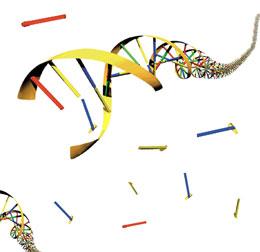Tantalizing clues to the chemical origins of life
June 15, 2009 | Source: Nature News
An artificial DNA-like molecule that can change its sequence to bind to a DNA template without the help of enzymes has been created by researchers at the Scripps Research Institute.

(Science/AAAS)
The thioester peptide nucleic acid (tPNA) has a peptide (amino acid) backbone on which bases anchor, analogous to the sugar-phosphates backbone on which bases anchor in DNA and RNA. When presented with a DNA template molecule, the tPNA reorganized itself until it had complementary (matching) base pairs.
The findings could shed light on how molecules underpinning life were first able to emerge from a chemical soup. If the system can can be designed to function as a gene, it would be a candidate for service as the genetic component in current efforts to construct a cell artificially.
Until now, scientists trying to make self-replicating systems have constructed long DNA- and RNA-like molecules from small, information-carrying units that stack together, in the same way that DNA stacks together from nucleotide units in nature. The problem with these is that, once assembled, the sequence of bases cannot usually be changed.